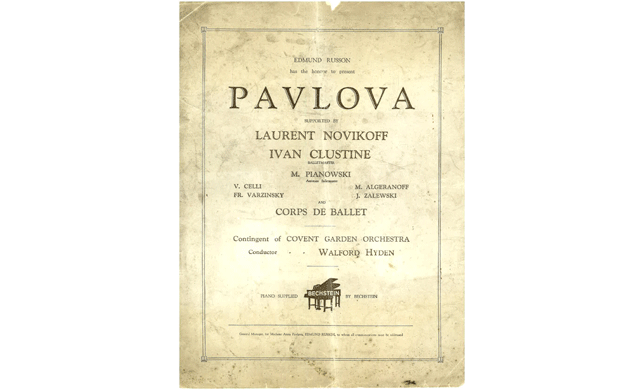Anna Pavlova was born in 1881 in St Petersburg on this day, February 12. In commemoration of her birthday, our latest blog post tells you all about her appearance here at Darlington Civic Theatre on what turned out, for more than one reason, to be a momentous day.
Anna Pavlova in Darlington
On the afternoon of Thursday 17th November 1927, Anna Pavlova performed at The New Hippodrome and Palace Theatre of Varieties. This was a momentous day for the theatre – the day an international ballet star, renowned for her solo ‘The Swan’, appeared in our town, arriving most probably at the Bank Top train station - not on the ‘fish and actors’ train but on her own special train - before performing in front of a packed house.
It was also the day that the owner and founding director of the theatre, Signor Rino Pepi, died.
Signor Pepi had recorded the momentous date in his diary. It might have seemed that most of Darlington turned out to see Pavlova, or at least knew someone who did. But Signor Pepi wasn’t there. He was at home, and he was dying. As Pavlova made her final révérence and left the Hippodrome to move on to her next engagement in York, Signor Pepi too made his exit. He died that night, aged only 55.
A fittingly theatrical exit. At least our founding managing director went out on a high. Pavlova was more than a dancer. She was an icon, a superstar, a celebrity who endorsed brands of shoes and created a frenzy at stations as she arrived and departed on her own special train. Although Russian, she based herself in London and it is in Britain, perhaps, that her legacy is the most widespread and enduring.
About Anna Pavlova
Anna Pavlova was born in 1881 in St Petersburg and trained as a dancer at the Imperial ballet school on Theatre Street (now Architect Rossi Street, thus renamed in 1923). Pavlova came from a modest background; an education at the Imperial ballet school was free (and has remained so, although following the 1917 Revolution the school ceased to be Imperial). Russia had begun to train its ballet dancers in the previous century, and they were initially the children of serfs who, when they weren’t being taught to dance, were also expected to work on the land. The Imperial ballet in St Petersburg was established in the 18th century at the will of Empress Catherine the Great, and the city’s Maryinsky Theatre was named after the Empress Maria Alexandrovna (wife of Tsar Alexander II). Prior to the Revolution, dancers at the theatre (and students at the school) were akin to members of the Tsar’s court.
Pavlova’s background, then, did not deter her from training as a dancer, and indeed many Russian dancers came from modest backgrounds and often from military or theatrical families. Pavlova, instead, was initially held back by her own physique. At the time, the fashion was for small, shapely virtuoso ballerinas, whilst Pavlova’s long, slender limbs and highly arched feet gave her a more fragile aesthetic and a different kind of technique.
Pavlova’s talent shone through, and despite her individual style, she graduated from the school to progress into the company where she quickly rose through the ranks.
Now a ballerina, Pavlova soon found her way to England and Paris, performing briefly with Sergei Diaghilev’s trailblazing Ballets Russes. Perhaps she was attracted to the itinerant life: instead of returning to St Petersburg, she founded her own company and settled in England. In 1912, Pavlova bought a house, Ivy House, in Golders Green in London, and for a time even set up a small school there. Ivy House still stands, and during this century it has been used as the premises of the London Jewish Cultural Centre, although in January 2015, following the merger of the LJCC with Jewish community centre JW3, the house was put on the market and is soon to become a primary school. Happily, today Pavlova’s beautiful, light-filled studio – complete with viewing gallery - is still used as a ballet studio by a private dance school.
As well as performing in Britain, Pavlova toured around the world, taking ballet to places it had rarely been seen before. Her influence had a great effect on the development of the fledgling ballet in Britain, an art-form which until the inter-war period, was performed in this country only in music halls.
Anna Pavlova’s influence on ballet in Britain
Born Edris Stannus in Co Wicklow, Ireland, in 1898, before later choosing a more theatrical name, Ninette de Valois trained alongside Noël Coward at Lila Field’s Academy. Having learnt Mikhail Fokine’s ‘The Swan’ - the solo originally created for Pavlova – de Valois later claimed to have danced it ‘on every old pier theatre in England’. De Valois went on to found the Vic-Wells Ballet and the Vic-Wells Ballet School – now the Royal Ballet, Birmingham Royal Ballet and the Royal Ballet School. Her life spanned three centuries; she died in 2001. Dame Ninette, or ‘Madam’ as she was known, came to pass on what she believed to be the original version of ‘The Swan’, teaching it to Royal Ballet ballerina Marguerite Porter, who in turn coached Marianela Nunez in the solo, preserving the original choreography for future generations.
In 1917 a young British boy, Frederick Ashton (1904 – 1988), saw Pavlova dance in Lima, Peru, where he lived at the time. It was the first ballet he had ever seen. That young boy subsequently became Sir Frederick Ashton, choreographer for Ballet Rambert and what became, upon receipt of the Royal Charter in 1956, The Royal Ballet. Ashton was Director of The Royal Ballet between 1963 and 1970 and his extensive legacy of ballets includes masterpieces such as Façade (1931), Symphonic Variations (1946), Scènes de Ballet and Cinderella (both 1948), La Fille Mal Gardée (1960) and A Month in the Country (1976).
Pavlova’s influence on Ashton was so great that many of his ballets include the ‘Fred step’, an enchaînement based on his memory of seeing Pavlova dance in Peru. A demonstration of this enchaînement can be found on the Royal Ballet’s YouTube channel.
What influence did Pavlova have on our audience here in Darlington? Did she inspire a young child to aspire to a performing career? She is part of our history, and part of the history of ballet in Britain, not only as a dancer but as a figure of romance and intrigue. Like Signor Pepi, she died young, aged only 49, on 23 January 1931 whilst on tour in The Hague. Legend has it that, on her deathbed, she requested that her Swan costume be brought to her. On the day of what would have been her next performance, the curtain went up and a single spotlight scanned the empty stage as Saint-Saens’ music played for her famous solo, ‘The Swan’; the solo she had danced here in Darlington a little over three years before.
Like Signor Pepi’s, Pavlova’s exit was fittingly theatrical.

